The Best Studio Headphones of 2023: Under $200 to $500
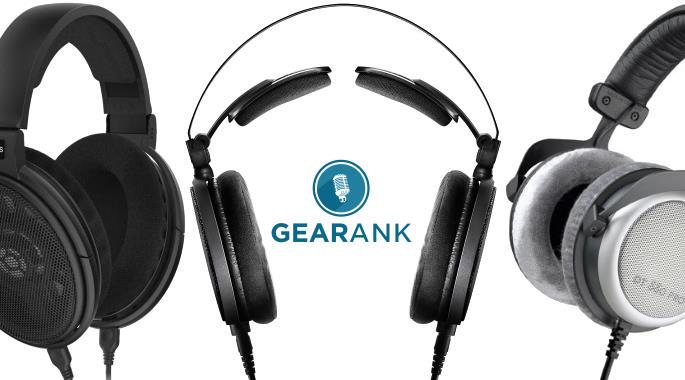
Author & Contributors
Raphael Pulgar
I've been an audio engineer for 20 years specializing in rock and metal recordings. I also play guitar and produce original music for my band and other content creators.
The main headphones I use in my studio are the Beyerdynamic DT 770 Pro (250 ohms) for tracking and Beyerdynamic DT 990 Pro for mixing and mastering. Additionally, I also own the Grado SR325, Hifiman He400i and Philips Shp9500 for further referencing.
Best Studio Headphones Under $200 - Max 250 ohm
Note: If you're looking for more affordable options then take a look at our guide to Studio Headphones Under $100.
Audio-Technica ATH-M50x
Cons
- Proprietary detachable cable
- Clamping can be a bit tight
- Faux leather earcups
Pros
- Deep and engaging sound
- Good isolation for mobile use
- Detachable cable
- Works well with various systems
The ATH-M50x Improves upon its predecessor with a detachable cable as an extra feature. This simple improvement makes it more portable and easier to maintain - more importantly it allows for easier and cleaner setups. Note that the detachable cable uses a proprietary locking connector, this means you can't use a generic replacement cord.
Like its predecessor the ATH-M50, theATH-M50x features a 45mm Driver with a Neodymium Magnet. It has a deep and engaging sound that works great with various systems. It also has good isolation that makes it useful even when working outside of the studio, suitable for mobile setups that utilize laptops or tablets.
The headband is a bit stiff resulting in clamping force that's a bit tight, but this helps with isolation and reduces the possibility of sliding out of position while moving.
It utilizes faux leather earcups, which may turn off those who are looking for high quality materials.
Hit albums have been produced and mixed with these headphones, really living up to its high ratings. Get it if you want a good pair of headphones for both recording and mixing in the studio or on the go.
Specifications
- Type: Closed-back
- Driver Size: 45 mm
- Magnet Type: Neodymium
- Frequency Response: 15 Hz to 28 kHz
- Impedance: 38 ohms
- Sensitivity: 99 dB
- Max Input Power: 1,600 mW
- Weight: 10 oz (285 g) without cable and connector
- Connectivity: 3 cables in total - Detachable 9.8' (3 m) straight and coiled cables + a single 3.9' (1.2 m) straight cable all with 1/8" plugs + a 1/4" screw-on adapter.
| Website | Source | *Rating Value |
| Sound On Sound | Sam Inglis | 85/100 |
| Pocket-lint | Mike Lowe | 100/100 |
| Gearank | Alden Acosta | 92/100 |
Beyerdynamic DT 770 Pro (80 Ohm)
Cons
- Cable is not detachable
- The sub-bass may not be deep enough for some
Pros
- Flat midrange
- Smooth low frequency bump
- Ideal for home studios
- Good build quality
The DT 770 Pro 80 ohm version shares the majority of features and sound signature of its 250 Ohm sibling.
For most home studios, 80 Ohms is the sweet spot for dynamic range and amplification requirements. Some audio interfaces may have trouble driving a 250 Ohm pair of headphones while 32 Ohms may not maximize the dynamic range that a higher end audio interface can provide.
Sitting at this comfortable middle ground, It has just the right amount of dynamic range and efficiency so you can listen properly with your studio setup and on a mobile devices for mix checking / referencing.
The DT 770 Pro 80 Ohm puts you front and center to a virtual hi-fi sounding studio monitor setup, with a relatively flat midrange and a smooth low frequency bump that extends further than other headphones. The lows are not as deep as some would want it, but it is tight enough for use in mixing.
If you want a pair of headphones that can give you all the information you need to balance out your low frequencies without a sub, while maintaining a tight response and being efficient enough to be used with most mobile devices, the DT 770 Pro 80 Ohm is your best bet.
Specifications
- Driver Size: 45 mm
- Frequency Response: 5 Hz to 35 kHz
- Impedance: 80 Ohms
- Sensitivity: 96 dB
- Max Input Power: 100 mW
- Weight: 270g without cable (0.55 lbs)
- Connectivity: 3m coiled cable with a gold plated 1/8" plug and 1/4" adapter.
| Website | Source | *Rating Value |
| Sound Guys | Christian Thomas | 77/100 |
| Equipboard | gchiaren | 100/100 |
Beyerdynamic DT 770 Pro (250 Ohm)
Cons
- Can get sibilant
- Pads pick up dirt and absorb sweat
- Non-detachable cable
Pros
- Great low frequency extension
- Neutral midrange
- Excellent comfort and fit
- Long term durability
When I started interning at a local studio and learning the ropes, the studio had a pair of Beyerdynamic DT 770 Pros that I absolutely adored using. At the time, I thought they were expensive headphones going for upwards of $400. I was surprised when I found out that they weren't as expensive as i thought. So when I started doing my own work and building up my own studio at home, they were the first on my list of purchases.
The DT 770 Pro sports 45mm drivers with Neodymium magnets. This gives it a fast response and great frequency range extension on the high and low end. Speaking of which, the low frequency range of the DT 770 Pro is one of the most balanced I've heard in a pair of headphones. It manages to avoid big spikes around 100Hz while extending the lows below 50hz smoothly. Most closed back headphones suffer from compromising low frequency extension with low frequency impact at the 100Hz area. The chamber tuning is one of the best in the industry. Despite being a closed-back design, it has very spacious soundstage.
The Midrange also sounds even across the range without any standout resonances or bumps. This makes balancing instruments with vocals intuitive and helps with translation to other listening devices. Continuing on to the high end, the extended frequency range gives just enough air to the headphones. This is where my gripes with this set of headphones start. It is VERY sibilant. Listening to Ariana Grande's "Positions" album was a painful affair and when I was tasked to reference it for a client's mix, I couldn't listen to it for more than 10 minutes without ear fatigue. Granted the album was noted by audiophiles to be a particularly sibilant master, The DT 770 Pro just emphasizes it to painful degrees. This can work to your advantage if you prefer warmer sounding mixes as the bias will make you cut more high end from your tracks. The problem is you might end up cutting too much. Cross referencing is key to take full advantage of the DT 770 Pro's low frequency and midrange strong points.
The DT 770 Pros were designed to be spartan and easily serviceable. The foam pads are washable and if they eventually give out, they are replaceable. This goes the same for the headband. Beyerdynamic sells spare parts in case your unit gives out. I've had my current pair for 6 years and I've only had to replace the foam pads twice in that time. The drivers are still holding up. They also have a good clamping force that doesn't feel uncomfortable. The plush pads help in that regard. This is important for long studio sessions where singers or engineers need to wear them for extended periods of time.

I tried to get this earcup as clean as possible for this shot. I used tape, and a small vacuum I use for keyboards but it's tough to get some of the dust and pet fur out without washing.
Note that the velour pads are prone to getting dirty. The pads and the inner foam are dust (and pet fur) magnets. Although removing them to clean them is easy, It's an added chore especially if they're studio headphones. For hygienic purposes, you may end up having to wash them after every session! The lack of a removable/replaceable cable has been a longtime concern for people but personally, I never found the coiled cable troublesome.
These are the 250 Ohm version which is best suited to use with higher end pro audio gear and the manufacturer also recommends this version for mixing. There are also 32 and 80 Ohm versions which are more suited to mobile devices and home studio / listening respectively.
The DT 770 Pro is a must have for every studio. It is a great all-rounder for tracking, mixing and even mastering when you have to check the low end balance of your tracks. The treble may be sibilant at times but once you get used to it, you will be rewarded with mixes that translate.
Specifications
- Type: Closed back
- Driver Size: 45mm
- Magnet Type: Not Specified
- Frequency Response: 5 - 35,000 Hz
- Maximum Input Power: Not Specified
- Sensitivity: 96 dB
- Impedance: 250 Ohms
- Weight: 9.52 oz.
- Cable and Connectivity: 9.8 ft. coiled cable Connection, 1/8" Gold plated stereo jack plug and 1/4" adapter (6.35 mm)
- Best For: Mixing, Mastering
| Website | Source | *Rating Value |
| Gearspace | Puffer Fish | 90/100 |
| Audiofanzine | livewidmusic | 100/100 |
| Gearank | Raphael Pulgar | 96/100 |
Beyerdynamic DT 990 Pro
Cons
- Open back leaks sound by design
- Non-detachable cable
Pros
- Treble exposes poorly mixed tracks
- Expansive, speaker-like soundstage
- Excellent comfort and fit
- Great Long term durability
Beyerdynamic headphones have been on my radar for a long time. The first one I got was a Beyerdynamic DT 770 Pro, which is a closed back headphone. While the 770 Pro had a wide soundstage and great bass for low frequency balancing, what it lacked is a sense of "airiness" that helps balance treble during mixing. I realized I needed an open back pair to complement the DT 770 pro and the DT 990 Pro fulfills that need.
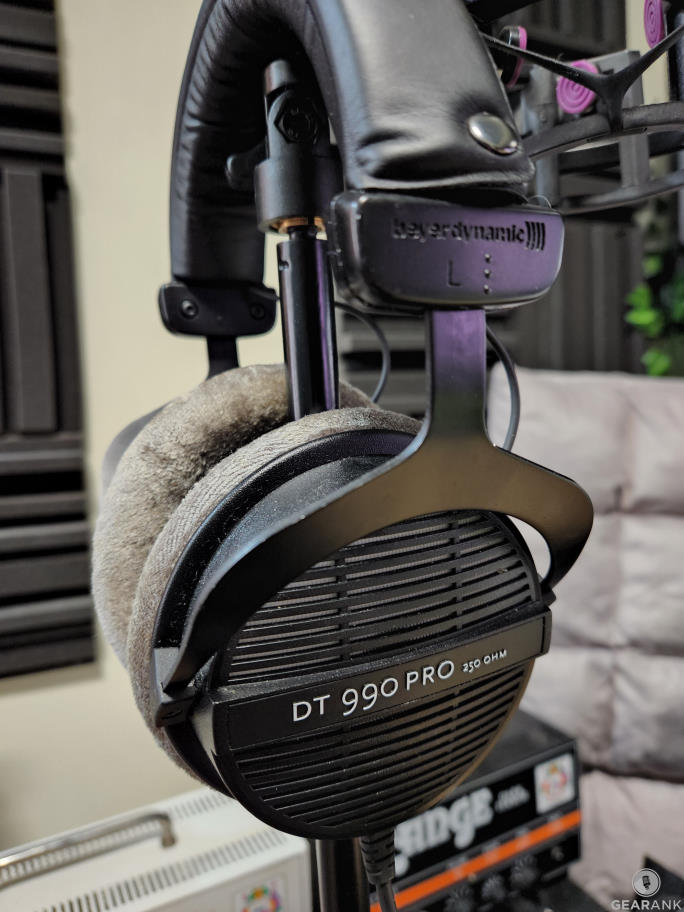
The DT 990 Pro has a vented open back. It's not as open as headphones like the Sennheiser HD 600 where you see the driver directly
They provide pleasant bass and precise trebles when it comes to frequency response. In addition, they come with a single-sided coiled cable with a gold-vaporized 1/8 inch (3.5mm) stereo jack plug and a 1/4 inch adapter, which is useful for switching from studio use to casual listening. The sound signature is bright and clear. It has a treble spike around the 10khz that audiophiles criticize for being too sibilant for some recordings. However, I use that spike to my advantage to avoid sibilance on my own mixes.
Another good thing about the headphone is how uncluttered the midrange is. Paired with its relatively wide soundstage, it helps place elements in a dense mix; something that I find the DT 770 Pro can't do quite as well. The bass frequencies have a focus around the 100hz to 200hz range which gives it a bit more thump than sub extension. This is good for balancing kick and bass guitar but because of the reduced sub frequency extension, cleaning up the lows is a task better suited to my DT 770 Pro.

The plush pads are comfortable for long listening sessions. My well loved pair however, is in need of a replacement set after 5 years of use because the foam has started to collapse.
A feature I like is their robust and soft padded headband, along with their cushion ear pads that are washable and replaceable. One important thing to note though that the DT 770 Pro and the DT 990 Pro have different earpads. The size and density of the foam are different. I've experimented with swapping them around and it throws off the sonic balance of both headphones. So if you're looking to replace them, Be sure to get the one that is specified for the model you're using.
Overall, the DT 990 Pro is an excellent choice if you're looking for a pair of mixing headphones to balance your high end and be more aware of sibilance. It's not the best for tracking as its open back so it's better as a supplementary pair than your main pair.
Specifications
- Type: Open-back
- Driver Size: 45 mm
- Magnet Type: Not Specified
- Frequency Response: 5 - 35,000 Hz
- Maximum Input Power: 100 mW
- Sensitivity: 96 dB
- Impedance: 250 Ohms
- Weight: 8.82 oz
- Cable and Connectivity: 9.8 ft. coiled cable, 1/8" Gold plated stereo jack plug and 1/4" adapter
| Website | Source | *Rating Value |
| Gearspace | Diogo C | 85/100 |
| Equipboard | lunoxismusic | 100/100 |
| Gearank | Raphael Pulgar | 94/100 |
Best Studio Headphones Under $500
Beyerdynamic DT 880 Pro
Cons
- Minor sound leakage
- Need proper ear position for optimal treble response
Pros
- Smooth low midrange to low frequency curve
- Ideal for singers who want to hear their voice
- Moderate Isolation
- Comfortable fit
The Beyerdynamic DT 880 Pro aims to combine the advantages of open-back headphones with those of closed-back studio headphones.
The moderate level of isolation prevents major sound leakage while providing a more open-sounding monitoring experience; useful for singers that want to track while hearing their voice.
It has smooth low midrange to low frequency curve without any narrow spikes in frequencies at that register, which makes it easier to make critical mix decisions when balancing lower frequencies.
The newly designed headband for the DT 880 Pro grants better wearing comfort, especially during long studio sessions. The comfort of this headband, together with its semi-open design make it a good choice for those who have to work on mixes for long hours.
High frequencies shift with headphone positioning over the ears, the solution was to find a good neutral position for the ideal balance of frequencies. While careful engineering was put into making isolation better, there will still be some sound leakage.
Although open-back by design, the DT 880 Pro is a spectacular performer for Mixing and Mastering duties. Singers who prefer open back headphones for monitoring will be comfortable with the pair. While there will still be some leakage, it's nothing a good noise gate cant handle during mixing if it means capturing a better performance from a singer that prefers to hear themselves.
Specifications
- Type: Semi-Open back
- Driver Size: 45mm
- Magnet Type: Not Specified
- Frequency Response: 5 - 35.000 Hz
- Maximum Input Power: 100 mW
- Sensitivity: 96 dB
- Impedance: 250 Ohms
- Weight: 9.52 oz.
- Cable and Connectivity: 3 m Coiled connecting cable with mini-jack plug (3.5 mm) & ¼“ adapter (6.35 mm)
- Best For: Mixing, Mastering
| Website | Source | *Rating Value |
| Sound Guys | Christian Thomas | 82/100 |
| Sonarworks | Indrikis | 92/100 |
Sennheiser HD 600
Cons
- No isolation, not ideal for vocal tracking
- Thin detachable cable
- Clamping force and pads are initially stiff
Pros
- Natural spatial sound
- Clean and neutral lows and highs
- Comfortable to listen in to, and to wear
- Sturdy build quality
The Sennheiser HD 600 is a recording community favorite that features a circumaural design with open metal mesh earpieces which deliver a more natural, spatial and accurate sound.
Matching it's open-back design are optimized magnets that provide dynamic and wide frequency response. The resulting sound is clean and neutral, with distortion free clear lows and smooth highs.
But it's not just for professional studio engineers, because audiophiles can also appreciate how comfortable it is to listen to, and to wear. It's not too overbearing, which makes for a more relaxed listening experience, be it for mixing or for simply enjoying music. The initial clamping force and pads were stiff at first but they became comfortable over time.
The included detachable cable is a bit thin and has proprietary connectors, but replacement parts are available.
Being open-back, it has little to no isolation, making it unusable for tracking vocals.
Sennheiser has hit a home run with the HD 600. They are a well-engineered marvel that has stood the test of time with the quintessential Sennheiser house sound tuned towards more critical listening. While their pedigree and lineage owe more to audiophile ears, details are not lost with the HD 600.
Specifications
- Type: Open-back dynamic
- Driver Size: 40 mm
- Magnet Type: Neodymium-ferrous
- Frequency Response: 12 – 40,500 Hz
- Maximum Input Power: 200 mW>
- Sensitivity: 97 dB
- Impedance: 300 Ohms
- Weight: 9.17 oz
- Cable and Connectivity: 9.8 ft oxygen-free copper cable
- Best For: Mixing, Mastering
| Website | Source | *Rating Value |
| Gearspace | Rev. Eslam | 86.7/100 |
| Audiofanzine | Blue Xrysalis | 80/100 |
Audio-Technica ATH-R70x
Cons
- For optimal sound, use high-powered headphone amps
- Not ideal for use in non-studio environments
Pros
- Open, spacious and airy sound
- Balanced highs and mids
- Deep bass but not too overwhelming
- Comfortable fit
Audio-Technica have been producing quality professional studio quality headphones for years, and this includes highly rated headphones like the ATH-R70x.
These open-back headphones feature transparent aluminum honeycomb-mesh housings engineered to provide a chamber free from standing waves and unwanted resonance. This results in an open, spacious and airy sound that makes it easier to listen to the tiniest details of each instrument in the mix.
The mids and highs are balanced without coloration, while the bass is deep without being too overwhelming.
Their light-weight yet robust construction, fabric earpads and improved wing and paddle mechanism provides comfort for long hours of listening.
With an impedance of 470 Ohms, this is meant for use with amps that have high output level, so pro studio gear or a dedicated headphone amplifiers are recommended. But it still provides good enough sound quality even when connected to less powerful devices, although this is not the intended use.
If you're looking to invest heavily in headphones for mixing, the ATH-R70x is head and shoulders above many. Transparency is the name of its game. What these excel at is disappearing from your perception and letting you hear the music without paying too much attention to what you're wearing. A top-of-the-line feeling.
Specifications
- Type: Open-back
- Driver Size: 45 mm
- Magnet Type: Neodymium
- Frequency Response: 5 - 40,000 Hz
- Maximum Input Power: 1,000 mW
- Sensitivity: 99 dB
- Impedance: 470 Ohms
- Weight: 7.4 oz
- Cable and Connectivity: Dual-sided detachable cable
- Best For: Mixing, Mastering
| Website | Source | *Rating Value |
| Sound On Sound | Sam Inglis | 96/100 |
| MusicTech | Editor | 90/100 |
| Gearspace | Reptil | 100/100 |
Sennheiser HD 660S
Cons
- Bass is a little lacking
- Not ideal for vocal tracking
Pros
- Pleasing and neutral sound
- Comparable to near field monitors
- Less ear fatigue
- Superb build quality
More than just a successor to the venerable 600 line, the HD 660S continues the standards established by the original flagship HD 600 as a set of critical listening headphones. For this iteration, Sennheiser improved and refined the winning formula by tuning the HD 660S to have a more hi-fi sound compared to its predecessors
Despite this direction, it still keeps the transient response and tightens up the low frequencies for a more accurate representation of the music and mix. The sound it produces is comparable to that of near field monitors, with frequencies that sit between pleasing and neutral.
This makes critical mix decisions easier to perceive, and at the same time, makes listening less fatiguing over extended mix sessions.
While it does have tight low-end, it can sound a bit lacking for those who prefer more bass oomph when they are mixing.
As expected from Sennheiser, build quality is top notch, reliable enough for professional use. If you want a high fidelity neutral sounding headphone with natural ambience then this is for you.
Specifications
- Type: Open-back dynamic
- Driver Size: 40 mm
- Magnet Type: Neodymium
- Frequency Response: 10 - 41000 Hz
- Maximum Input Power: 500 mW>
- Sensitivity: 104 dB
- Impedance: 150 Ohms
- Weight: 9.17 oz
- Cable and Connectivity: 9.8' cable, 1/8" stereo jack plug and 1/4" adapter
- Best For: Mixing, Mastering
| Website | Source | *Rating Value |
| Audio Science Review | amirm | 94/100 |
| Sound Guys | AJ Wykes | 74/100 |
Things To Consider When Buying Studio Headphones
-
As mentioned previously, closed back headphones are ideal for recording and monitoring because they prevent any sound leakage and block out external noise. They are also a better choice for playing guitar through headphones. And they are ideal for listening to guitar amp mic positions. Open-back headphones are suited to mixing and mastering as they have a more natural sound and even frequency response. However they allow a lot more sound to leak out and in so you may have to be more conscious of how the sound might get picked up by microphones in proximity. With better engineered headphones however, the compromises between both blur: Closed back headphones can be used during mixing to check the low frequency balance for transients like kick drums versus sustained lows like bass. Open-back headphones can be used for tracking to some extent where the artist is in the control room while an amplifier is in the live room. This gives them a more natural sensation of their amp compared to monitoring with closed back headphones. Open and Closed Back Headphones have their own advantages and disadvantages.
-
The best headphone brands build headphones that have an extended range below and beyond the average levels of human hearing, which is from 20 Hz to 20 000 Hz. It's highly suggested to look for headphones that provide as close as possible to a balanced and neutral frequency response, especially for mixing and mastering. For monitoring, this isn't as crucial as the performer usually isn't hearing a complete mix but it is still desirable to have the best sound possible.
Transient response refers to how fast the diaphragm returns to the neutral position after a sound is played. This affects clarity and bass tightness. Faster transient response enables you to perceive impacting sounds better and more accurately set compressor attack settings to squeeze out more percussive sounds from drums and slapped bass.
-
Comfort is one of the essential features when looking for a pair of headphones, especially when you plan to use them for producing music or casual listening for long hours. All the studio headphones in our list are circumaural which means they fit around the ear. This is the most comfortable style for listening over longer periods of time.
If possible, you should be able to place the ear cups around your ears with the right amount of space for them to fit nicely. Ideally you shouldn't need to be at the end of the range of any adjustments allowed by the headphones. The earpad cushioning material should be soft enough for comfort and ideally allow some breathability. The weight of the headphones and headband can also have an impact after long hours of listening. Finally, another factor is having the right amount of clamping force so they sit comfortably and securely on your head without too much pressure.
Most quality headphones are made with durable materials that can last you a lifetime. But sometimes various parts such as the earpads can wear out over time. It's best to check if there are replacement parts available for the headphones you invest in and also check the manufacturer's warranty.
-
Most headphones have a single sided cable attached to one ear cup. It's recommended to avoid really long cables since they can tend to get tangled. Also, having coiled cables provides useful flexibility. Some headphones have detachable cables which offer greater flexibility as they can be replaced with whatever length or type you need. They're also less prone to damage and can allow easier storage.
-
Impedance is how much resistance the headphones provide to the source. Higher output amplifiers or interfaces are generally best for higher impedance headphones while lower impedance would be easily driven by most interfaces and mobile devices. Running a low impedance headphone with a high output interface or amplifier is fine if you control your volume. However, matching a high impedance headphone with a low output sound source like cheaper interfaces or mobile sources may result in the driver being underdriven. Cranking low output sound sources may result in output stage distortion and may affect your perception of the mix.
In this edition, we decided to limit our Under $200 selections to headphones below 250 Ohms. Anything beyond 250 Ohms won't be optimal unless you use separate amplification. In our research, 250 Ohms is the upper limit for many audio interfaces.
Open vs Closed Back: A Case of Isolation and Frequency Response
Frequency Response and Transient Response
Comfort and Durability
Cable Connectivity
Impedance
Best Studio Headphones Selection Methodology
The first Edition was published in 2018.
We looked at all headphones below $500 commonly used in studios, available from major music gear retailers in the USA, and entered them into our music gear database - we had a total of 38 sets on our short-list for closer examination. We then gathered over 97.400 ratings, reviews and forum posts by users. Processing this enormous amount of data would be time consuming to analyze manually, hence all gathered data was processed with the Gearank Algorithm to produce the rating scores out of 100 you see above. Our selections reflect the best of the best according to all these sources. For more information about our methods see How Gearank Works.
About the Author and Contributors
Here are the key people and sources involved in this guide's production - click on linked names for information about their music industry backgrounds.
Lead Author & Researcher
Raphael Pulgar
I've been an audio engineer for 20 years specializing in rock and metal recordings. I also play guitar and produce original music for my band and other content creators.
Some of the recording gear I use in my studio includes the Focusrite Scarlett 18i20, Focusrite Scarlett Solo, Samson QH4 Headphone Amp and Cloudlifter CL-1. My mics include Aston Origin, Aston Element, Shure SM57, Rode NT1, Rode PodMic and MXL V67G.
Contributors
Alden Acosta: Product research.
Jason Horton: Editing and Illustrating.
Media
Main/Top Image: Created by Gearank.com using photographs of the Sennheiser HD 660S, Audio-Technica ATH-R70x and Beyerdynamic DT 880 PRO headphones.
The individual product images were sourced from websites, promotional materials or supporting documentation provided by their respective manufacturers with the exception of the additional photos for the Beyerdynamic DT 770 Pro (250 Ohm) and Beyerdynamic DT 990 Pro which were taken by the author.



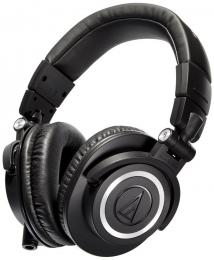
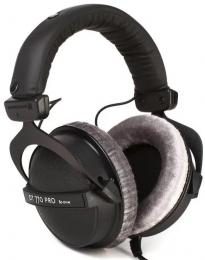
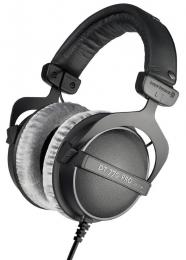
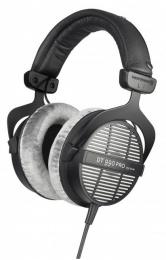
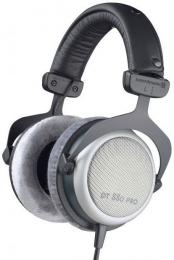
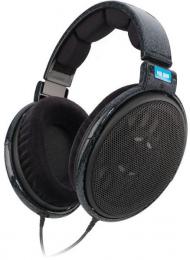
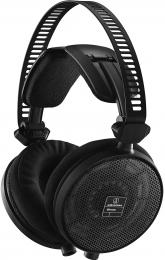


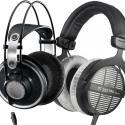
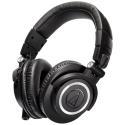

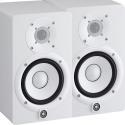
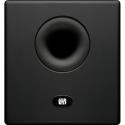
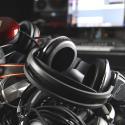
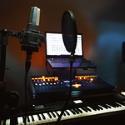
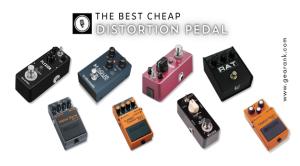
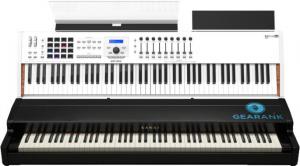
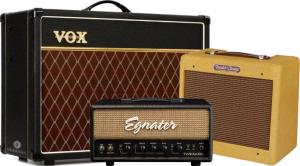
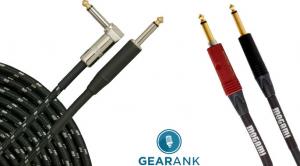
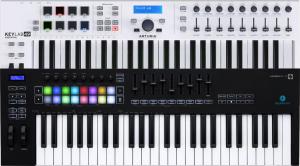
Comments
Why is the DT 880 priced
Submitted by Matthew (not verified) on
Why is the DT 880 priced higher than the 770 and 990? Is it better quality? Like maybe the drivers are better matched or the grills or damping in it is better in some way?
Hi Matthew,
Submitted by Raphael Pulgar on
Hi Matthew,
As far as I know, the number isn't meant to denote any tier or quality difference though historically, the DT880 was the flagship headphone for Beyerdynamic for a long time before being superseded by the T1. So maybe it has more to do with the engineering behind them.
Judging by the specifications:
DT770 = closed
DT880 = semi-open
DT990 = open
There is also the distinction between the "Edition" and "Pro" versions of these headphones with the "Pro" versions directed towards the studio market segment with higher Ohm ratings, reportedly harder clamping force and coiled cables. The "Edition" models are more geared towards the audiophile/prosumer market and are generally priced higher. The two versions are tuned slightly different from my limited testing experience.
As for driver matching, I can't say much about Beyerdynamic's manufacturing process but to my knowledge, they are all Made in Germany with different enclosures and maybe different driver spec for each.
I own a DT770 Pro and it's the pair I use to check my low frequency balance. I just placed an order for a DT880 Pro and DT990 Pro after writing this guide too (side effect of doing a lot of research!)
Anyway, I hope that helped!
-Raphael
Thanks, I appreciate it.
Submitted by Matthew (not verified) on
Thanks, I appreciate it.
Our January 2021 update
Submitted by Jason Horton on
Our January 2021 update resulted in the following headphones coming off the recommended list above, but you can still see our analysis of them:
As a result of our February
Submitted by Jason Horton on
As a result of our February 2020 update the following headphones came off the recommended list above: